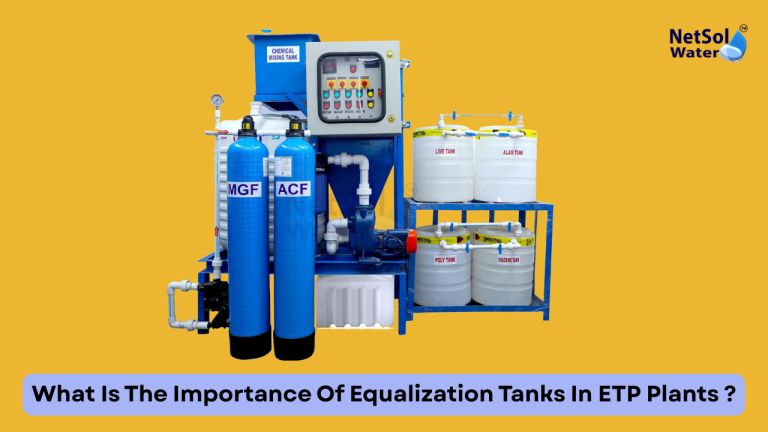
Effluent Treatment Plants are required for treating industrial effluents before releasing it into the environment. ETPs operate on the basis of various components put together to manage the quantity and quality of effluent. One such component, normally not considered much but highly necessary, is the equalization tank. So, What Is The Importance Of Equalization Tanks In ETP Plants ? Simply put, they are buffers—absorbing the variation in the flow rate and pollutant concentration of the incoming wastewater. This is essential to make the treatment process efficient and stable.
Importance of Equalization Tanks in ETPs
1) Coping with Flow Rate Variations
In all but a few industries, wastewater is not generated at a constant flow. There could be periods of peak production or days when the effluent volume is significantly larger. When this spasmodic flow is directly pumped to the biological or chemical treatment process, it will overburden the system or make treatment uneven.
That is where equalization tanks are required. Equalization tanks store and meter the inflow such that the treatment units get a steady, manageable quantity. This role highlights the importance of equalization tanks in ETPs, especially in those operations where activities are batch-type or intermittent.
2) Stabilizing Pollutant Load
As is the case with flow rates, wastewater quality also fluctuates. One batch might contain high organic levels, another chemicals or heavy metals. This type of variability can lead to failing biological processes, ruin sensitive equipment, or lead to regulatory non-compliance.
By retaining and blending wastewater, equalization tanks serve to homogenize the pollutant load. In other words, the downstream treatment processes get a more consistent influent, and they can operate more efficiently and in a predictable manner.
3) Increasing Efficiency of Treatment Units
Most of the treatment processes—biological, chemical, or physical—are designed to work within specific flow and concentration conditions. Sudden fluctuations in either will reduce their performance. For instance, high organic load can asphyxiate aerobic systems, while high flow rate can reduce retention time, which can be disadvantageous for chemical reactions.
Equalization tanks give the initial protection against such interference. Through contaminant smoothing and flow, they allow pumps, aerators, chemical dosing devices, and biological reactors to operate efficiently. Improved performance translates directly into equalization tanks playing a major role in ETPs because they allow economical and safe operation.
4) Protection of Downstream Equipment
Wastewater can contain abrasive solids, oils, or high pH levels that are hazardous to downstream equipment like pumps, membranes, or diffusers. Equalization tanks provide a period for pre-treatment processes (like pH correction or grit removal) to be effective before further process treatment, reducing wear and tear on expensive machinery.
Additionally, when the pH is excessively high or low, equalization tanks allow a buffer time to correct it prior to the water continuing further. This precautionary function gives an added reason to the importance of equalization tanks in ETPs —they prolong equipment life and save maintenance costs.
5) Backup Emergency Storage
Sudden process shutdown, power failure, or maintenance activities can interrupt the usual operation of ETPs. Under such circumstances, equalization tanks serve as buffer storage for wastewater to prevent overflow or unauthorized discharge.
This backup storage capacity augments the importance of equalization tanks in ETPs through added flexibility and robustness of the overall treatment system. It’s not only a matter of day-to-day functioning but also about being in a position to cope with the unexpected without losing compliance or safety.
6) Improved Monitoring and Automation Enablement
Equalization tanks often are equipped with level sensors, mixers, aerators, and pH control systems. These pieces of equipment allow plant operators to monitor influent characteristics in real time and adjust before problems arise. They also make treatment step automation simpler, leading to better control and fewer operator actions.
Thus, the utility of equalization tanks in ETPs also includes making room for wiser, data-based plant operation.
Conclusion
The equalization tank, though frequently underrated, forms an important part of an Effluent Treatment Plant . It plays important roles like maintaining influent flow rate regulation, smoothing pollutant load fluctuations, protecting downstream treatment processes, and allowing emergency storage capacity. Such functionalities make the equalization tank a necessary element to ensure consistent and effective wastewater treatment. So when you talk about what is the importance of equalization tanks in ETP plants all we discuss the points above are telling the importance of equalization tanks in etp plant.
Knowing the importance of equalization tanks in ETPs assists industries in planning effective treatment systems, reducing operation problems, and remaining compliant with environmental regulations. In wastewater treatment, balance is essential—and equalization tanks are the key to achieving that balance.
Do you need an advice or assistance on selecting the best water and waste water treatment unit? We have solutions for all your problems!
Let us know your problem, our experts will make sure that it goes away.
For an assistance or related query,
Call on +91-9650608473
Or write us at enquiry@netsolwater.com
